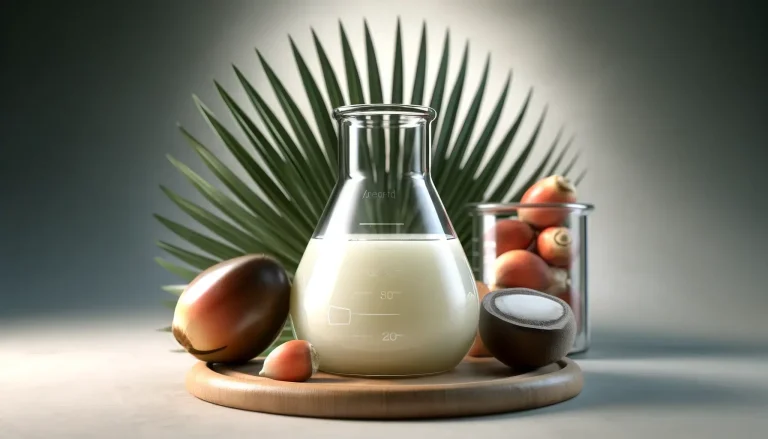- Monday to Friday (9-6 PM)
- info@naturzindustries.com
Ever wondered about the differences between Palm Stearin and Stearic Acid? In this guide, we’ll unravel their distinctions and explore how they’re used in various applications. Let’s dive in!
Well, it’s like this solid fraction of palm oil, kind of like when you chill soup and the fat separates out. Palm stearin mostly has these saturated fatty acids, giving it that solid texture at room temp.
People use it in all sorts of stuff, from food like margarine and baking fats to non-food things like cosmetics and candles. It’s pretty versatile stuff!


Palm stearin, with its versatile properties, finds widespread application across various industries. In the food sector, it enhances the texture and flavor of products like margarine, butter, dairy items, and ice cream.
Beyond food, palm stearin’s consistency determines its utility:
Soft Consistency:
Hard Consistency:
From adding richness to food products to serving as the backbone of crafting materials, palm stearin proves its adaptability across a spectrum of applications.
An 18-carbon fatty acid lacking a double bond. It’s obtained from the glycerol molecule through a chemical process known as hydrolysis.
Stearic acid is a type of saturated fatty acid commonly found in animal and vegetable fats. It’s solid at room temperature and has various uses across industries. In cosmetics, it acts as an emulsifier and thickening agent, while in pharmaceuticals, it’s used in tablet coatings. In the food industry, it’s used as a stabilizer and emulsifier in products like ice cream and candy. Additionally, stearic acid has applications in candle making, plastics, and rubber production.
Stearic acid stands as a prominent figure in the chemical realm, a term known to many or at least heard of by all.
To grasp the essence of stearic acid, let’s delve into the realm of lipids—oils and fats, the source of stearic acid.
Lipids, fundamentally, are glycerol molecules bonded to one, two, or three fatty acids. The fatty acid’s distinguishing characteristics lie in its carbon chain length and the presence of double bonds or “unsaturations.”
Depending on the number of double bonds, fatty acids are categorized as follows:
The stearic acid we’re familiar with is an 18-carbon fatty acid devoid of a double bond. Obtained through a compound process known as hydrolysis, it can originate from both animal and vegetable fats. As the name suggests, it’s an “acid,” necessitating special precautions in handling, both in terms of safety and equipment.
While both Palm Stearin and Stearic Acid share similarities in their fatty acid composition, they exhibit distinct characteristics and applications.
In essence, while Stearic Acid represents a specific type of fatty acid, Palm Stearin signifies a fraction of palm oil with diverse applications and properties.
Palm stearin and stearic acid serve various industries due to their unique properties:
Food Industry: Palm stearin enhances texture and flavor in products like margarine, butter, and ice cream. Stearic acid acts as a stabilizer and thickening agent in food and beverage items.
Cosmetics: Both are used in cosmetics; palm stearin in skincare products for its emollient properties, while stearic acid serves as an emulsifier and stabilizer.
Pharmaceuticals: Stearic acid is used in pharmaceuticals for tablet coatings, while palm stearin finds applications in lipid-based drug delivery systems.
Candle Making: Palm stearin and stearic acid are used in candle making for their ability to harden and stabilize candles.
Plastics and Rubber Production: Stearic acid is utilized as a lubricant and mold release agent in plastics and rubber manufacturing processes.
These versatile substances play crucial roles across various sectors, contributing to product quality and functionality.
In summary, both Palm Stearin and Stearic Acid play significant roles across diverse industries, yet they possess distinct characteristics and applications.
Palm Stearin: Derived from the fractionation of palm oil, it offers versatility in applications, ranging from food products like margarine to non-food items like candles. Its varying consistencies cater to a wide array of uses, making it a valuable ingredient in numerous sectors.
Stearic Acid: This saturated fatty acid, obtained from animal fats and vegetable oils, serves as a stabilizer, emulsifier, and thickening agent in the food and beverage industry. Its presence in various grades ensures its suitability for different applications, from pharmaceuticals to candle making.
Understanding these differences enables us to harness the unique properties of Palm Stearin and Stearic Acid, contributing to innovation and advancement across various sectors.
Naturz Industries Sdn Bhd [202001019018 (1375338-K)] founded in 2020, is a leading exporter of palm oil and its derivatives. Our business encompasses the manufacturing, marketing, and exporting of RBD palm oil, RBD palm olein, shortening, vegetable ghee, and frying fat.